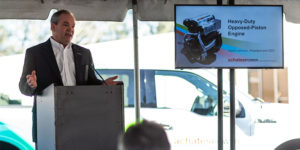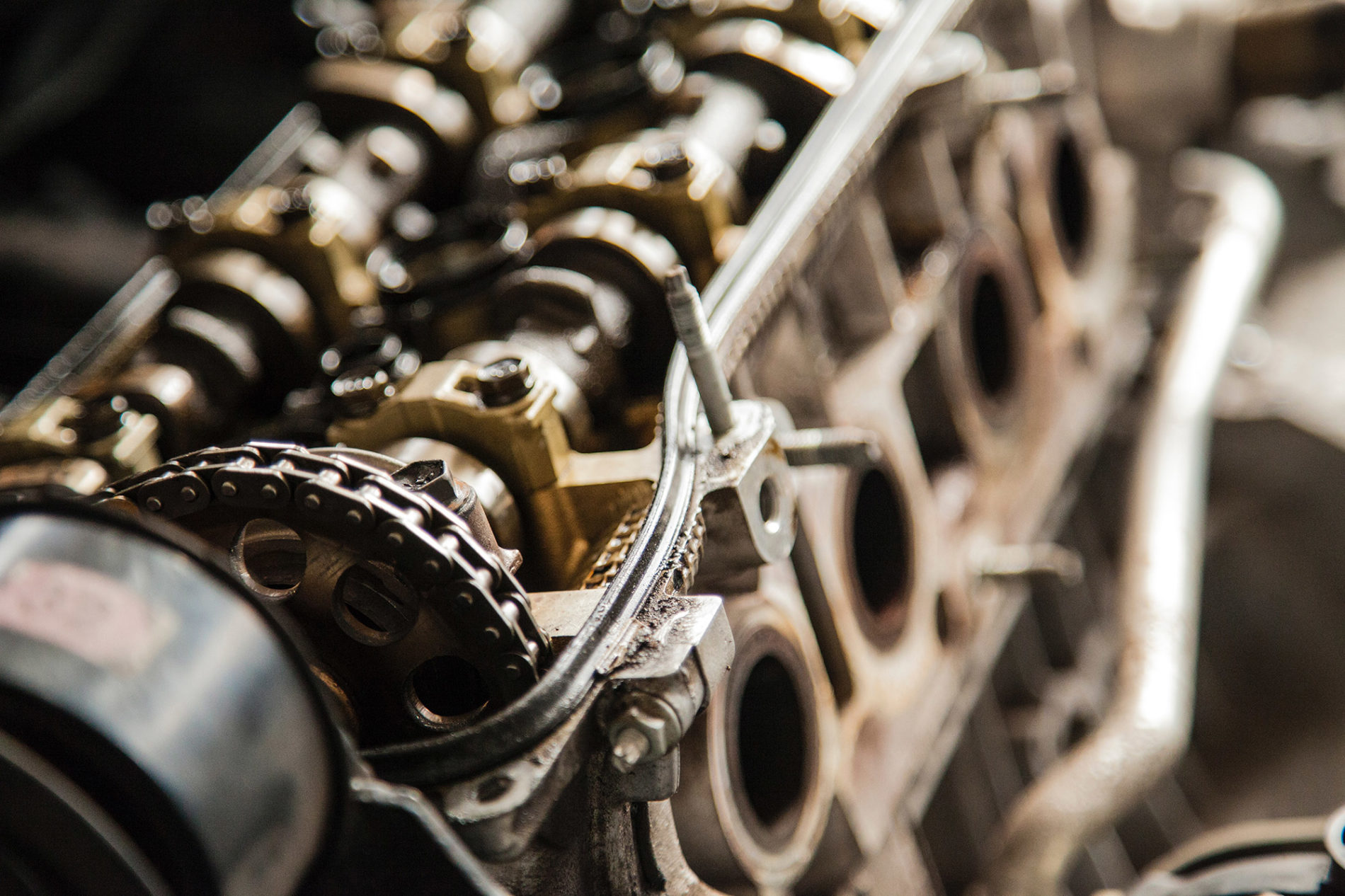Engine developer Achates Power said it’s moved a big step closer to commercialization of a super-clean, fuel-efficient diesel engine for heavy trucks.
Laboratory testing shows that the privately held, San Diego-based company’s unusual opposed piston engine – scaled up to deliver 450 horsepower and 1,750 pound-feet of torque – produces 90 percent fewer NOx emissions than the current federal standard for diesels.

Peterbilt will supply the first two Class 8 trucks to use Achates opposed piston, 10.6-liter diesel engine now under development. (Photo: Achates Power)
NOx, or nitrogen oxides, are emissions formed by the combustion of fossil fuels. They are regarded as one of the most toxic of all combustion engine emissions and are harmful to humans, animals and plants.

Achates Chief Executive David Johnson announces that opposed piston diesel engine test results show ultra-low NOx, greenhouse gas emissions. (Photo: Achates Power)
The 10.6-liter engine also produces almost 15 percent fewer greenhouse gas emissions – predominately carbon dioxide – than California’s standard for diesel, David Johnson, Achates president and chief executive, told Trucks.com.
Those are levels no standard diesel can approach and that have only been matched by compressed natural gas engines, said Bill Van Amburg, executive vice president of Calstart, a Pasadena, Calif.-based clean transportation technologies booster.
“We have to move faster than ever to clean up diesel emissions,” VanAmburg told Trucks.com. “Before, with diesel, we could get clean or we could improve efficiency, but this Achates engine shows we can do both” without abandoning the massive diesel infrastructure underpinning commercial freight transportation around the globe, he said.
The U.N. Intergovernmental Panel on Climate Change recently found that temperatures are rising faster than previously thought. A World Health Organization report shows worsening air quality in urban areas. Both reports underscore the need for speed, VanAmburg said.
Speed is relative, though. It’s likely Achates won’t market the engine sooner than 2023, Johnson said.
The company’s heavy-duty engine is still in development and won’t be ready for road testing until late next year and into 2020, he said.
Those tests will start with a pair of Class 8 Peterbilt trucks from Paccar. One Achates-powered truck will be placed in everyday service in California with Tyson Foods, the other with Walmart.
Opposed piston technology places pairs of pistons, facing one another, in single cylinders. Achates’ heavy-duty engine has six pistons but is classed as a three-cylinder engine. “OP” engines can be configured to operate on diesel or gasoline.
The opposed piston engine burns fuel more efficiently and activates its emissions-after-treatment system faster than is possible with conventional diesel engines.
The engine should cost no more than a conventional diesel – they have many parts in common. In early development, Achates “is experiencing a significant [cost] reduction” of the engine’s diesel emissions after-treatment system because it’s much smaller, Johnson said. It also uses less expensive catalyst material than a conventional diesel.
The engine is being developed in a $16 million private-public program funded in part by revenue raised from carbon credit auctions in California’s greenhouse gas reduction cap-and-trade program.
The California Air Resources Board, which administers the program, has approved a $7 million grant to Achates. Two regional air quality boards overseeing the Southern California and San Joaquin Valley areas are each contributing $1 million. Remaining funding for the heavy truck engine comes in cash and in-kind contributions from Achates and its development partners and suppliers.
In addition to the heavy truck engine, Achates is working with diesel giant Cummins Inc. on a 14.3-liter, four-cylinder military version for use in the Bradley fighting vehicle.
Achates also is developing a 2.7-liter gasoline opposed piston engine for light trucks in partnership with Aramco, the U.S. arm of giant Saudi Arabian Oil Co.
The engine is expected to deliver at least 37 mpg configured for gasoline and 42 mpg in diesel format. The gas engine efficiency is more than 40 percent better than the EPA’s 26 mpg highway rating for the 2018 Ford F-150 with the 2.7-liter EcoBoost V6 engine.
Achates does have one commercial version of its engine technology in the market already: It is used by Wisconsin-based Fairbanks Morse in its 12-cylinder Trident OP stationary power generating diesel.
For light and heavy trucks, the technology “is very promising, and there’s little doubt that it should be a lot more efficient and cleaner than conventional diesel,” Sam Abeulsamid, a transportation energy analyst with Navigant Research, told Trucks.com
“The big question is whether they can move to commercialization before battery, fuel-cell and hybrid electric powertrains become the standard,” he said, predicting that that could happen as early as 2030.
Johnson said he’s not concerned. He believes the clean, efficient internal combustion technology will work side by side with electric power in the transportation industry for decades to come.
Originally posted by John O’Dell on Trucks.com (November 12, 2018) (View Original Article)
